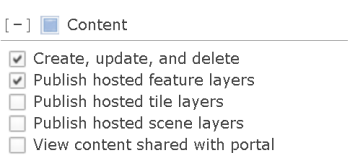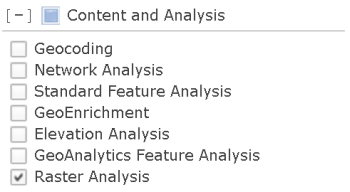ArcGIS Image Server includes distributed raster analysis and distributed image processing. ArcGIS Image Server distributed analytics can work with a single large raster dataset, such as world elevation, or a high resolution satellite image. It can also be applied to massive collections of imagery, such as the current Landsat 8 archive or the growing Sentinel-2 archive.
Raster analysis provides scalable distributed processing for large image and raster collections, including your existing GIS and imagery data. With Portal for ArcGIS, you can use built-in raster analysis tools to process and create new persisted layers, which can be made available as image and feature web layers.
The following are two examples of performing raster analysis:
- Computing vegetation coverage surface from multiple band imagery, so you can make an agricultural assessment
- Finding suitable locations to build solar power plants, using statewide elevation and land cover data
Access the raster analysis tools
The raster analysis tools can be used in the portal Map Viewer, in ArcGIS Python API, ArcGIS REST API, and ArcGIS Pro.
Access the tools from the portal Map Viewer
- Sign in to the portal as a member with the proper privileges.
In order to perform raster analysis, the minimum set of privileges needed are publishing and raster analysis:
- Content—Create, update, and delete and Publish hosted feature layers
- Content and Analysis—Raster Analysis


For more information about setting up the proper privileges, see Configure the portal to perform raster analysis .
- Click Map to open the Map Viewer.
- Click Analysis and choose the Raster Analysis tools.
Note:
If you do not see the Analysis button or the Raster Analysis tab in the Map Viewer, contact your portal administrator. Your portal may not be configured with ArcGIS Image Server, or you may not have privileges to run the tools. If you do not have the permissions required for the tools, they will not be visible.
Portal Map Viewer tool overview
You can run the raster analysis tools on the following two data types:
- Imagery layers
- Feature layers
The following tables contain descriptions of the raster analysis tools. The analysis tools are arranged in categories. These categories are logical groupings and do not affect how you access or use the tools in any way.
Analyze Image
These tools derive information from imagery based on algorithms for a specific purpose such as vegetation analysis, change detection or image classification.
| Tool | Description |
|---|---|
Monitor Vegetation | This tool performs an arithmetic operation on the bands of a multiband raster layer to reveal vegetation coverage information of the study area. The output of this tool is a hosted imagery layer. |
Analyze Patterns
These tools explore spatial patterns in your data.
| Tool | Description |
|---|---|
Calculate Density | This tool creates a density map from point or line features by spreading known quantities of some phenomenon (represented as attributes of the points or lines) across the map. The result is a layer of areas classified from least dense to most dense. The output of this tool is a hosted imagery layer. |
Interpolate Points | This tool allows you to predict values at new locations based on measurements from a collection of points. The tool takes point data with values at each point and returns the predicted values. The output of this tool is a hosted imagery layer and a hosted feature layer—in the form of a table. |
Analyze Terrain
These tools calculate slope, aspect, and viewshed surfaces from Digital Elevation Models (DEM).
| Tool | Description |
|---|---|
Calculate Slope | This tool creates a surface that shows the slope of the input elevation data. Slope represents the rate of change of elevation for each digital elevation model (DEM) cell. The output of this tool is a hosted imagery layer. |
Create Viewshed | This tool creates areas where an observer can see objects on the ground depending on the topography. The input observer points can represent either observers (such as people on the ground or lookouts in a fire tower) or observed objects (such as wind turbines, water towers, vehicles, or other people). The resulting areas are regions viewable from the observers and vice versa—where the observed objects can be viewed by the observers. The output of this tool is a hosted imagery layer. |
Derive Aspect | This tool creates an aspect map from an elevation data source. Aspect identifies the downslope direction of the maximum rate of change in value from each cell to its neighbors. Aspect can be thought of as the slope direction. The values of the output raster will be the compass direction of the aspect. The output of this tool is a hosted imagery layer. |
Manage Data
These tools are used to manage image data, which includes clipping/masking, remapping pixel values, and converting to and from feature data.
| Tool | Description |
|---|---|
Convert Feature To Raster | This task converts features to a raster dataset. Any feature class containing point, line, or polygon features can be converted to a raster dataset. The output of this tool is a hosted imagery layer. |
Convert Raster To Feature | This tool converts a raster to a feature dataset, as points, lines, or polygons. The output of this tool is a hosted feature layer. |
Extract Raster |
This tool can clip a raster to boundary, either to a rectangular area or to a shape you define interactively on the screen. You can clip to the extent of the area you currently have displayed on your map or by the study area defined by a polygon. The output of this tool is a hosted imagery layer. |
Remap Values | This tool allows you to change or reclassify the pixel values of the raster data. Pixels values are remapped by specifying a range of pixel values to map to an output pixel value. The output pixel value can be a valid value or a NoData value, which are pixels that do not have a known value associated with it. The output of this tool is a hosted imagery layer. |
Summarize Data
This tool allows you to use one dataset to define areas you want to summarize from the values of another dataset.
| Tool | Description |
|---|---|
Summarize Raster Within | This tool summarizes a raster based on areas (zones) defined by the first input layer. The output of this tool is a hosted imagery layer. |
Access the tools from ArcGIS Python API
ArcGIS Python API allows GIS analysts and data scientists to query, visualize, analyze, and transform their spatial data using the raster analysis tools available in their organization. To learn more about the analysis capabilities of the API, see the documentation site.
The raster analysis tools can be accessed via the raster module.
Access the tools from ArcGIS REST API
Besides the user interface clients ArcGIS Pro or Map Viewer, raster analysis services can also be accessible through the ArcGIS REST API. The Raster Analysis service tasks, based on geoprocessing tools, provide popular raster analysis tools categorized by tasks that analyze patterns, analyze terrain, manage data, summarize data, process raster data using parallel processing and classify data.
In addition to the Raster Analysis service tasks above, distributed raster analysis can be performed utilizing individual raster functions, or raster functions combined in raster function chains, using the Generate Raster analysis tool. This tool takes a well-defined raster function JSON object as input, and perform analysis based on the function definition. The user can either directly use the system built in raster function we support today or their own custom raster models. See Raster function objects for the substantial list of available functions for distributed raster analysis processing and storage of distributed output.
Access the tools from ArcGIS Pro
Raster Analysis tools can be accessed from the portal from ArcGIS Pro. See the help documentation in ArcGIS Pro for more details.